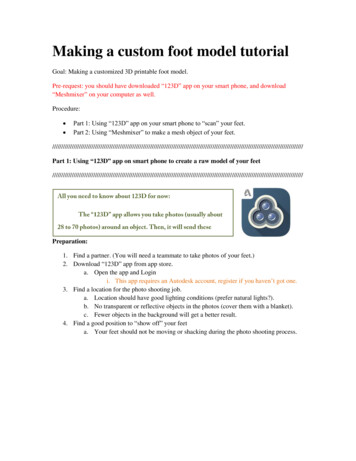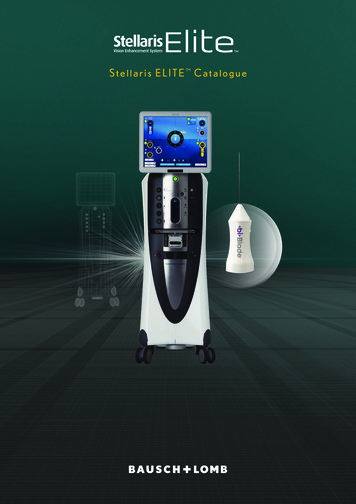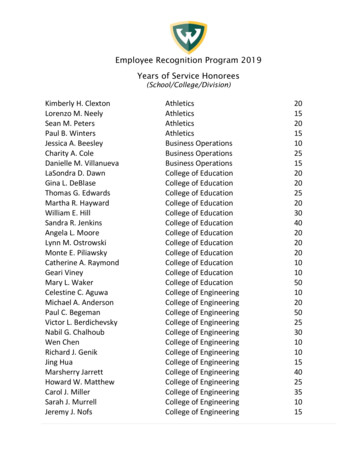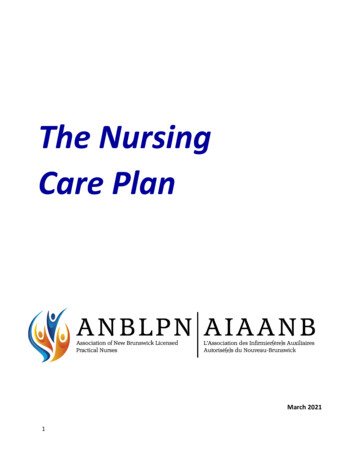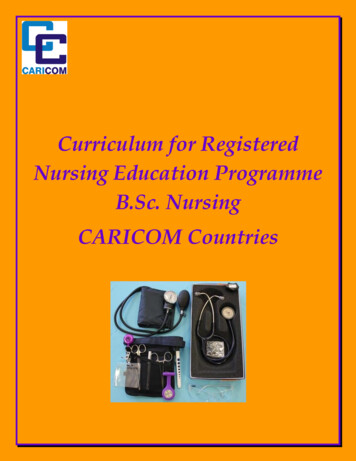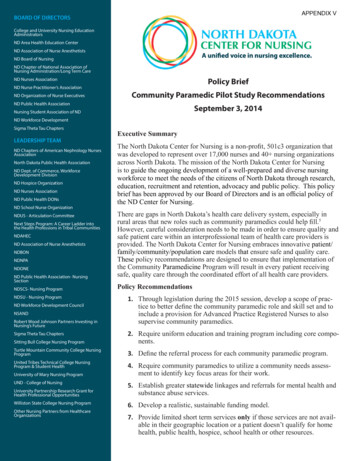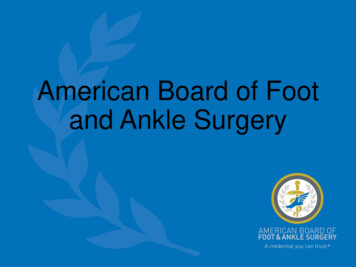
Transcription
Nursing Foot CareCollege of LicensedPractical Nurses of Manitoba463 St Anne's RoadWinnipeg, MB R2M 3C9Practice DirectionPractice directions assist practical nurses in understanding their responsibilities and legal obligations,enabling them to make safe and ethical decisions within their practice. Practical nurses are expected tocomply with the information disseminated in practice directions. Failure to do so may result ininvestigation for misconduct and/or an audit of the nurse’s practice.PurposeThis practice direction provides licensedpractical nurses (LPNs), employers, and thepublic with information about the professionalexpectations of LPNs who engage in nursingfoot care practice in Manitoba.Scope of Foot Care PracticeBasic Foot Care: The nursing care componentsof basic foot care do not require formal postbasic education. The competencies needed tocarry out basic foot care, including assessment,hygiene, and patient teaching, are entry-levelcompetencies for LPNs in Manitoba.Toenail cutting is also a component of basicfoot care for all clients. However, even if theclient is not experiencing any lower leg or footissues, the mere presence of certain diseases(e.g., diabetes, peripheral vascular disease)increases the risk associated with cuttingtoenails. LPNs are expected to use theirprofessional judgment as they prepare to cutthe toenails of a client with such medical issues.The more the client’s lower leg and foot areimpacted by disease, the more likely the LPNshould possess post-basic foot carecompetencies to prevent, anticipate or manageany complications which may be associatedwith cutting toenails.Nursing Foot CareA CLPNM Practice DirectionOctober, 2021Page 1 of 9Post-Basic Nursing Foot Care: Performing postbasic nursing foot care interventions requires:specialized knowledge, skill, and judgment;completion of the CLPNM-approved post-basiceducation program; and current competence.Post-basic nursing foot care practice includes: assessment of past medical history including,but not limited to, Diabetes Mellitus,Peripheral Vascular Disease, or PeripheralNeuropathy assessment of circulation assessment of skin integrity, foot, and nailstructure determining and implementing a plan ofnursing foot care that is consistent withrecognized standards of practice that mayinclude: hygiene and shortening of toenails forclient with, or at high risk for, disease orpathology affecting the lower leg or foot debridement (manual or mechanical) andbuffing or reducing of corns and callusesto the level of the dermis that may requirethe use of a grinder with a sanding disc ordrum evaluation of client status andeffectiveness of the plan of nursing footcare, and client referral for treatment of a disease orcomplication and/or corrective footweardevices.
Differences Between Basic and Post-Basic Nursing Foot CareBasic Foot Care1Post Basic Nursing Foot CareKnowledgeKnowledge anatomy and physiology of the feet and lowerextremitiescommon microorganisms of the feetasepsis and infection controlcomplications of diabetes and its effect on thefeeteducation of client and caregiver basic foot care knowledge, andpathophysiology as it relates to chronicdisease and the feet (e.g., diabetes andperipheral vascular disease)changes in the feet because of chronicdisease(s)best practices in infection control related tocleaning and sterilizing instrumentsfootwear assessmentthe scope of practice of other foot healthprovidersSkillSkill assessing and inspecting of the footperforming of non-invasive foot-careprocedures: cleansing moisturizing toenail trimmingeducating clients and caregivers basic foot care skills, andadhering to the principles, applications, andcontraindications of padding and offloadingoperating of a rotary fileperforming interventions for the commonpathologies of the feet (e.g., corns,calluses, dystrophic nails)JudgmentJudgment making practice decisions based on assessingthe client without disease or pathologyaffecting the lower leg or foottaking appropriate action when assessmentfindings are not as expecteddocumenting and reporting appropriatelytaking appropriate action when a client'sneeds exceed their scope of practice orindividual competence, such a referring toanother health care providerNursing Foot CareA CLPNM Practice DirectionOctober, 2021Page 2 of 9 basic foot care judgment, andmaking practice decisions based onassessing a client with or at high risk fordisease or pathology affecting the lower legor foottaking appropriate action when assessmentfindings are not as expecteddocumenting and reporting appropriatelytaking appropriate action to refer the clientto the appropriate foot health care provider
Wound Care and Conservative Sharp WoundDebridementequips the LPN with theoretical knowledge andclinical competency in:LPNs practising post-basic nursing foot caremay encounter clients with lower extremitywounds. While there is an overlap in thecomponents of foot care and wound care, thefocus of post-basic nursing foot care is onwound prevention, not wound treatment 2. In particular, clients with diabetes who developa foot ulcer must be referred to, and treatedpromptly by, an interprofessional healthcareteam with expertise in treating foot ulcers toprevent recurrent foot ulcers and amputation 3.The LPN must recognize a situation where theclient's needs are outside of their individualscope of practice, experience, or competencylevel and appropriately seek guidance or referthe client.The competence needed to performconservative sharp wound debridement (CSWD)with a scalpel or other sharp instrument toremove hyperkeratotic lesions (i.e., corns andcalluses) is not taught in the CLPNM-approvedpost-basic nursing foot care program. CSWDmay only be executed by an LPN who hasacquired additional education and training inCSWD and has submitted proof of successfulcompletion to the CLPNM.The additional education required to performCSWD to remove hyperkeratotic lesions mustequip the LPN with the knowledge, skill, andjudgment required to perform the procedureand to address and manage any adverseoutcomes.Educational Requirements for Post-BasicNursing Foot CareLPNs must complete the CLPNM-approvednursing foot care program to practice post-basicnursing foot care in Manitoba. This programNursing Foot CareA CLPNM Practice DirectionOctober, 2021Page 3 of 9 changes in the foot due to age and chronicdiseasescommon foot pathology and related nursinginterventionsfoot and lower extremity anatomy andphysiologyfootwear assessmentinfection controlnursing assessment of the foot and lowerextremitystructure and function of the foot and nail,anduse of instruments commonly used innursing foot care.Assiniboine Community College (ACC) deliversthe only CLPNM-approved nursing foot careprogram. The ACC program comprises 116hours of theory and 32 hours of clinicalpractice. The CLPNM does not approve footcare programs outside of Manitoba.Proof of Eligibility to Practise Post-Basic NursingFoot CareThe LPN must arrange for ACC to submit anofficial transcript to the CLPNM denotingsuccessful completion of the CLPNM-approvedfoot care education program before they maypractise post-basic foot care in Manitoba. TheCLPNM will make an internal notation on theLPN's registration, confirming they haveattained the necessary education. Thisinformation is not displayed on the CLPNMpublic register but is considered publicinformation and is shared if the CLPNM receivesan inquiry.Barring any other registration relatedrestrictions or conditions, after an LPN hascompleted the CLPNM-approved post-basicnursing foot care program and has confirmedthat the CLPNM has received the required
documentation as outlined above, they are thenauthorized to practise post-basic nursing footcare. The LPN may provide nursing foot care toclients in multiple settings, including hospitals,personal care homes, community health clinics,and private homes.The Practice of Post-Basic Nursing Foot CareLicensed practical nurses provide nursing footcare services within the parameters of theirCLPNM approved education, training, andexperience, and as per The Licensed PracticalNurses Act CCMS L125 (2001), the CLPNMStandards of Practice, the CLPNM Code ofEthics, and any other related CLPNM PracticeDirection.Principles of Infection ControlFoot care devices have been associated withinfections and outbreaks; therefore, each clientinteraction requires a sterile set of foot careequipment and devices 4, 5.LPNs providing nursing foot care areresponsible for ensuring that the client is notplaced at risk of infection when reusing any footcare equipment/devices during the provision ofcare 4.Reprocessing reusable foot careequipment/devices shall meet manufacturers'instructions for use, current national guidelinessuch as the Canadian Standards Association(CSA), the Public Health Agency of Canada(PHAC/Health Canada), Infection Preventionand Control Canada (IPAC), and regionalstandards2, 4-7.Medical equipment/devices used to provide footcare must be approved or licensed for medicaluse and designed for humans, specifically, feet(e.g., rotary sanding device and accessories) 4.Nursing Foot CareA CLPNM Practice DirectionOctober, 2021Page 4 of 9Policies and ProceduresWhether an LPN practising foot care is selfemployed (i.e., independent practice) or worksfor an organization, policies, and proceduresmust provide clear direction on all aspects ofnursing foot care. Nursing foot care policies andprocedures must also be consistent with theCLPNM Entry-level Competencies, the NursingCompetencies for Licensed Practical Nurses inManitoba, the Standards of Practice, the Codeof Ethics, any other related CLPNM practicedirection, and best practice guidelines.LPNs who practice nursing foot care asemployees of an organization must advocate forpolicies and procedures to guide safe nursingfoot care practice and must collaborate with theemployer, as needed, to develop policies andprocedures.Examples of foot care policies and proceduresinclude, but are not limited to: billing processescare planningconfidentiality of personal healthinformationdocumentation and record retentionhealth history and lower limb assessmentinfection prevention & controlnail splintingobtaining informed consentreduction of corns & callusesreferralsSelf-Employment and Nursing Foot CareLPNs who practice nursing foot care in a selfemployed capacity must establish and annuallyreview and revise their policy and proceduredocuments to reflect current legislation,standards, and best practice guidelines. 10Self-employed LPNs who employ others mustensure that their staff has a working knowledgeof the policies and procedures.
LPNs who provide post-basic nursing foot careservices in a self-employed capacity are alsoexpected to comply with the CLPNM PracticeDirection on Self-Employed Practice.collective consideration of client conditions orfactors affecting the status and needs of theclient, the abilities and attributes of theindividual LPN, and the characteristics andresources of the environment.Risks Associated with Post-Basic Nursing FootCare 11The context of practice greatly influences thelevel of risk involved in providing post-basic footcare. Context of practice determines theappropriate application of LPN practice with theThe context of practice guides individualdecision-making in specific practice settings orsituations.Context of Practice and Levels of Risk in Post-Basic Nursing Foot CareLowest RiskThe lowest level of risk in providing post-basic nursing foot care to clients is when the LPN works asan employee and regularly provides nursing foot care services. This might be in a personal care home or community health centre, or any area where anauthorized professional qualified to diagnose and prescribe treatment (physician, podiatrist,nurse practitioner) is readily available for consultation. In these settings, the LPN is employed by the agency or facility. There is often regularoversight of the LPN's practice by a manager, and other healthcare professionals whoprovide care to the client are present for collaboration and referral. There are employer policies and procedures related to foot care services. While collaborationand client-centered care is expected, these policies and procedures are the employer'sresponsibility, not the individual LPN. The employer is responsible for putting in place policies and physical, technical, andadministrative security safeguards that are necessary to protect client confidentiality. TheLPN is responsible for following health record creation, retention, confidentiality, andsecurity policies that the employer establishes. The employer is likely to carry liability insurance that provides some degree of coverage fortheir staff, in addition to the liability insurance the LPN holds as an individual practitioner. The risk of infection transmission is more easily managed when the employer providesaccess to equipment and facilities necessary to adhere to infection prevention and controlregulations.Nursing Foot CareA CLPNM Practice DirectionOctober, 2021Page 5 of 9
Moderate RiskWhen the environment shifts into a practice setting with increasing independence, the risks shift toa more moderate level. The LPN might provide post-basic foot care services as an employee of a home careprogram or be employed by another regulated nurse operating nursing care services. Inthese scenarios, the LPN’s supervisor/manager may not directly oversee the LPN’s practice. There may be no manager or interprofessional team immediately available to the LPN forguidance and support. The risk of infection transmission may be more difficult for the LPN to manage, as the LPNmay have more difficulty accessing the equipment and facilities necessary to adhere toinfection prevention and control regulations.Highest RiskThe most significant risks exist in providing post basic foot care as a solo and/or self-employedpractitioner. If the LPN receives payment for services directly from a client (or another payee), the LPN isself-employed. All the risks normally managed by the employer, in the low and moderaterisk scenarios above, now become the responsibility of the LPN who is self-employed. Inthese conditions, there can often be significant additional responsibilities and risks. The LPN is solely responsible for equipment management, infection control, obtaininginformed consent, liability coverage and risk mitigation, referral practices, and for developingand implementing policies to guide their practice. Services are often provided via a mobile service model and in inconsistent and uncontrolledenvironments. Patients may be less able to assess the quality of services they receive. Referral resources may be limited. LPNs are responsible for maintaining a transparent fee schedule and accurate records. The LPN is responsible for the creation and maintenance of a health record system, and formaintaining its security and confidentiality. There is no manager or team available for consultation therefore the LPN must establishtheir own network for support and guidance to improve the quality of their practice. There is no manager to recommend or arrange access to education and training that mayassist the LPN in keeping their skills up to date.Nursing Foot CareA CLPNM Practice DirectionOctober, 2021Page 6 of 9
As the risk level associated with the LPN’spractice context increases, the LPN requires ahigher level of individual competence andresources to appropriately manage the risks.Whether services are provided in self-employedor an employer/employee model, all LPNs areaccountable for providing safe, ethical, andcompetent care, and are accountable for theirpractice and their decisions.Titles and AbbreviationsThe CLPNM does not authorize the use of titles,signatures, or abbreviations that convey that anLPN has attained a specialized foot carecredential either directly or by implication. Thisincludes, but is not limited to, the use of: the term certified concerning nursing footcare, such as the title Certified Foot CareNurseany abbreviation that implies certification innursing foot care, such as CFCNthe title foot care nurse as part of thenurse's signature, orany abbreviation that implies a specializedfoot care credential or designation, includingbut not limited to the abbreviation FCN.Using such titles and abbreviations provides theimpression that a formal foot care credentialhas been conferred or that a higher level ofacademic certification was achieved. Therefore,it may mislead the public.For clarity, it is acceptable, when describing thenurse's practice, to identify that the nursepractices nursing foot care or that the nurse isa foot care nurse, just as it is appropriate for anurse working in primary care to identifythemselves as a primary care nurse. Suchdescriptions provide information about thenurse's area of practice. When not used inconjunction with certified or as part of thenurse's signature, they do not imply aprofessional designation. It is also acceptableNursing Foot CareA CLPNM Practice DirectionOctober, 2021Page 7 of 9for a nurse who has done so to communicatethat they have completed AssiniboineCommunity College's Nursing Foot Careprogram.Professional Development and ContinuingCompetenceTo maintain competence, LPNs who practisepost-basic nursing footcare are responsible forpractising regularly and for completing at leastone learning plan related to their nursingfootcare practice each year in connection withCLPNM’s Continuing Competence Program.Refer to the CLPNM’s Practice Direction on theContinuing Competence Program for moreinformation.In addition, LPNs who practice nursing foot carein a self-employed capacity must also ensurethat they meet all requirements in the CLPNM’sPractice Direction on Self-Employed Practice,including the requirement to practise aminimum of 250 hours of foot care, per year, tomaintain their competence, as a requirement ofongoing registration.LPNs who take a short period of time awayfrom their nursing foot care practice must, priorto their returning to nursing foot care practiceconduct a self-assessment, identify any gaps intheir knowledge, skill, and judgment, anddevelop and implement a plan to restore theircompetence before resuming foot care practice.In these circumstances, to restore competence,the LPN may need to undertake learningactivities beyond completing the two learningplans required for the CCP. As an example, thisplan might include requesting to shadow or bementored by another nurse, for a period oftime, who practises nursing foot care.LPNs must recognize that taking long periodsaway from nursing foot care practice may leadto competence gaps that can only be addressedby undertaking the CLPNM-approved Nursing
Foot Care program anew. LPNs are expected todemonstrate insight and prudent judgementwhen assessing their own competence.Post-basic nursing foot care is practised with ahigh degree of independence. LPNs practisingpost-basic nursing foot care must criticallyappraise their own nursing foot care practice toidentify opportunities to enhance theirknowledge, skill, and judgment. This includesengaging with colleagues and peers in providingand obtaining mutual mentoring and support toimprove the quality of practice. Nursespractising foot care are also expected to usecurrent knowledge and evidence-informedclinical practice standards and guidelines.Recommended topics to remain up to date onrelated to nursing foot care include, but are notlimited to: chronic disease management includingdiabetes managementfootwear assessmentinfection controlpreventative healthcarehealth record, storage, retrieval, andsecurity, andcultural competence and health equity.For More InformationVisit our website at www.clpnm.cafor more information and resources.Contact us with questions at463 St. Anne’s RoadWinnipeg MB R2M 3C9Phone: 204-663-1212Toll Free: 1-877-633-1212Email: info@clpnm.caAbout the CLPNMThe CLPNM is the governing body for thelicensed practical nursing profession inNursing Foot CareA CLPNM Practice DirectionOctober, 2021Page 8 of 9Manitoba. Mandated to govern its members in amanner that serves and protects the publicinterest, the CLPNM establishes practicerequirements for the provision of safe andeffective nursing care.ResourcesResources relevant to nursing foot care andLPN practice in Manitoba, include:CLPNM ResourcesEntry-Level Competencies for the LicensedPractical Nurse in ManitobaNursing Competencies for Licensed PracticalNurses in ManitobaDetermining Appropriate LPN Practice: A Guideto Decision-MakingCLPNM Code of EthicsCLPNM Standards of PracticeCLPNM Practice Direction - InterprofessionalCollaborative CareCLPNM Practice Direction – Self-EmployedPracticeThese resources can be accessed from theCLPNM website n and Practice ResourcesAssiniboine Community College - ContinuingStudies https://assiniboine.net/programs/csCanadian Association of Foot Care Nurseshttps://cafcn.ca/
Diabetes Canada – Clinical Practice on Prevention and Control Canada (IPAC)- Guidelines & delines.phpManitoba Association of Foot Care Nurseshttps://mafcn.ca/Wounds Canada – Best Practice sThe following documents were consulted duringthe development of this practice direction.1. College of Licensed Practical Nurses ofPrince Edward Island. Practice directive:Foot care. 2019; ice-DirectiveFoot-Care-February-2019.pdf.2. Gallagher, D., The certified foot care nurseand the importance of comprehensive footassessments. J Wound Ostomy ContinenceNurs, 2012. 39(2): p. 194-6.3. Embil, J.M., et al., Foot Care. CanadianJournal of Diabetes, 2018. 42: p. S222–S227.4. Infection Prevention and Control Canada.Reprocessing of critical foot care devices(Position statement). 2019; Position%20Statement%20%20 ReprocessingCriticalFootCare RevisedJuly2019.pdf.Nursing Foot CareA CLPNM Practice DirectionOctober, 2021Page 9 of 95. Centers for Disease Control and Prevention,Healthcare-associated hepatitis b and coutbreaks ( 2 cases) reported to thecenters for disease control and prevention(CDC) 2008-2017 2018: Atlanta, GA.6. Winnipeg Regional Health Authority,Nursing foot care infection prevention &control management in community healthservices (Policy #90.00.020). 2013:Winnipeg, MB.7. Canadian Standards Association, Canadianmedical device reprocessing (CAN/CSAZ314-18). 2018: Toronto, ON.8. College of Podiatrists of Manitoba. Standard4: Infection control guidelines. 0Control%20Guidelines.pdf.9. Public Health Agency of Canada, Infectioncontrol guidelines: Foot care by health careproviders. Canadian Communicable DiseaseReport, 1997. 23S8 (Supplement): p. 2-iii 2-6.10. Canadian Association of Foot Care Nurses.National competencies for advanced nursingfoot care in Canada. .11. Saskatchewan Association of LicensedPractical Nurses. Practice guideline: Basicfoot care and advanced foot care. -2021.pdf.
Wound Care and Conservative Sharp Wound Debridement LPNs practising post-basic nursing foot care may encounter clients with lower extremity wounds. While there is an overlap in the components of foot care and wound care, the focus of post-basic nursing foot care is on wound prevention, not wound treatment 2.

